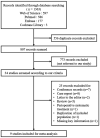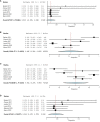Neoadjuvant therapy in pancreatic neuroendocrine neoplasms: A systematic review and meta-analysis
- PMID: 36505835
- PMCID: PMC9731099
- DOI: 10.3389/fonc.2022.981575
Neoadjuvant therapy in pancreatic neuroendocrine neoplasms: A systematic review and meta-analysis
Abstract
Background and objectives: Neoadjuvant therapy plays an increasingly important role in pancreatic neuroendocrine neoplasms (pNENs), but the systematic evaluation of its efficacy is still lacking. The purpose of this study is to explore the role of neoadjuvant therapy in pNENs.
Methods: We systematically reviewed the literatures published online until October 1, 2021. Meta-analysis was conducted to generate proportion with 95% confidence intervals (95% CI) for tumor response, resection rate, R0 resection rate and survival time.
Results: Nine studies with 468 patients were involved in the systematic review. None of these patients met complete response (CR). Furthermore, 43.6% (95% CI [18.1, 69.0]) patients were expected to achieve partial response (PR), 51.3% (95% CI [27.9, 78.3]) to stable disease (SD), and 4.3% (95% CI [0.7, 7.9]) to progressive disease (PD). The estimate resection rate and R0 resection rate after neoadjuvant therapy were 68.2% (95% CI [44.5, 91.9]) and 60.2% (95% CI [53.5, 66.9]), respectively. There was no significant difference in resection rate between different chemotherapy regimens (41.67% vs 33.93%, P=0.453), as well as R0 resection rate (62.50% vs 68.30%, P=0.605). In terms of objective response rate (ORR), there was no significant difference between CAPTEM and FAS (41.67% vs 33.93%, P=0.453), while PRRT showed a higher ORR compared with chemotherapy, although there was also no statistical difference (49.06% vs 36.96%, P=0.154).
Conclusion: Neoadjuvant therapies could reduce the tumor size and stage of some borderline resectable or unresectable pNENs, and give some patients the chance of radical resection. However, according to the current data, the best treatment regimen for pNENs neoadjuvant therapy is still unknown.
Keywords: neoadjuvant therapy; pancreatic neuroendocrine tumor; prognosis; surgery; tumor response.
Copyright © 2022 Li, Fan, Zhang, Yang, Shi, Liu, Meng and Zhan.
Conflict of interest statement
The authors declare that the research was conducted in the absence of any commercial or financial relationships that could be construed as a potential conflict of interest.
Figures





Similar articles
-
FOLFIRINOX-based neoadjuvant therapy in borderline resectable or unresectable pancreatic cancer: a meta-analytical review of published studies.Pancreas. 2015 May;44(4):515-21. doi: 10.1097/MPA.0000000000000314. Pancreas. 2015. PMID: 25872127 Review.
-
Short-term outcome of neoadjuvant immunotherapy and chemotherapy in non-small cell lung cancer: A systematic review and meta-analysis.JTCVS Open. 2021 Sep 2;8:588-607. doi: 10.1016/j.xjon.2021.08.036. eCollection 2021 Dec. JTCVS Open. 2021. PMID: 36004199 Free PMC article.
-
CT-determined resectability of borderline resectable and unresectable pancreatic adenocarcinoma following FOLFIRINOX therapy.Eur Radiol. 2021 Feb;31(2):813-823. doi: 10.1007/s00330-020-07188-8. Epub 2020 Aug 26. Eur Radiol. 2021. PMID: 32845389
-
How to approach pancreatic cancer after neoadjuvant treatment: assessment of resectability using multidetector CT and tumor markers.Eur Radiol. 2022 Jan;32(1):56-66. doi: 10.1007/s00330-021-08108-0. Epub 2021 Jun 25. Eur Radiol. 2022. PMID: 34170366
-
Total neoadjuvant therapy for initially inoperable pancreatic cancer: A systematic review of phase 2-3 studies.Radiother Oncol. 2021 Nov;164:13-19. doi: 10.1016/j.radonc.2021.09.001. Epub 2021 Sep 10. Radiother Oncol. 2021. PMID: 34509562
Cited by
-
Critical appraisal of the adequacy of surgical indications for non-functioning pancreatic neuroendocrine tumours.BJS Open. 2024 Jul 2;8(4):zrae083. doi: 10.1093/bjsopen/zrae083. BJS Open. 2024. PMID: 39107074 Free PMC article.
-
Treatment of Pancreatic Neuroendocrine Tumors: Beyond Traditional Surgery and Targeted Therapy.J Clin Med. 2025 May 13;14(10):3389. doi: 10.3390/jcm14103389. J Clin Med. 2025. PMID: 40429384 Free PMC article. Review.
References
-
- Tang LH, Untch BR, Reidy DL, O'Reilly E, Dhall D, Jih L, et al. . Well-differentiated neuroendocrine tumors with a morphologically apparent high-grade component: A pathway distinct from poorly differentiated neuroendocrine carcinomas. Clin Cancer Res (2016) 22:1011–7. doi: 10.1158/1078-0432.CCR-15-0548 - DOI - PMC - PubMed
Publication types
LinkOut - more resources
Full Text Sources
Research Materials
Miscellaneous

